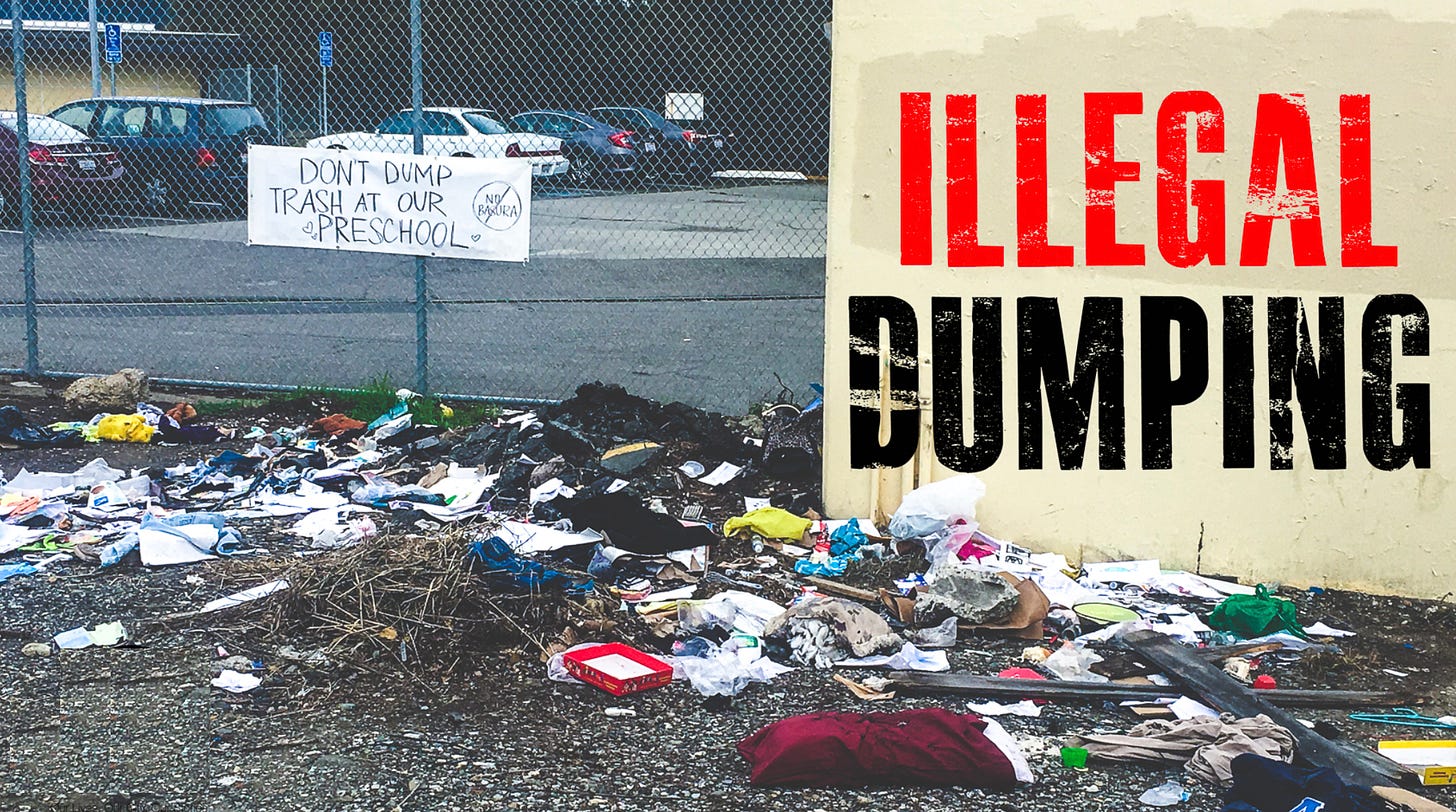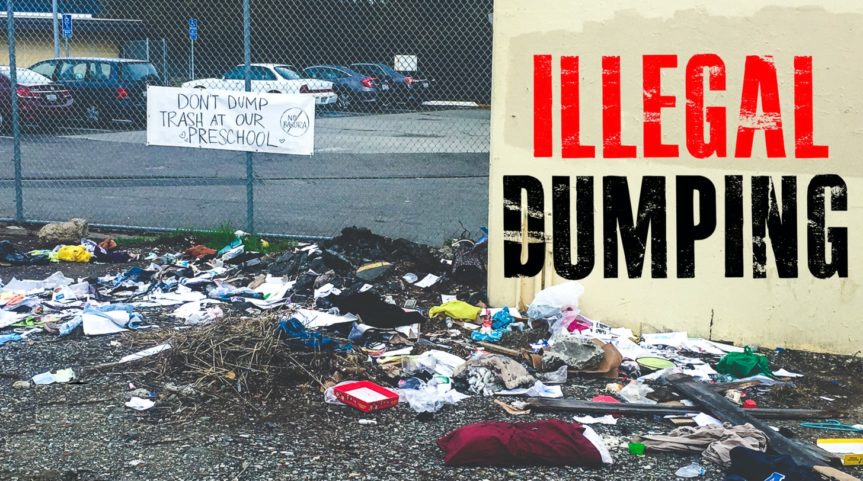| A guest post from James Harris from his excellent Town Biz blog |

Illegal dumping is a health hazard; it may cause fatigue and depression among the residents and families that live near frequent dump sites, and it is associated with high crime, but it is still one of the fastest growing problems our major cities are facing.
In 2018, San Francisco reported about 82,000 instances of illegal dumping. Sacramento City and County had almost 20,000 instances in 2017 and San Jose had 21,000 reported incidences in that same year. If you live next to or in a major city, simply, Google “illegal dumping” and your city name, and see what is being done to combat the effort. Here in Oakland, in 2017 we had about 33,000 occasions of illegal dumping— that’s about 2,750 pickups each month or about four instances of illegal dumping occurring every hour during that year.
Even as I write this, I know it will likely be another story that is perhaps shocking, but will likely be filed away on a list of things that are worthy of consideration, but simply too massive and complex to mount a force to defeat. But, I figure it’s worth continued discussion because the families and communities being impacted are the same communities we have been trying to rescue from high crime, underperforming schools, and food deserts.
It seems the more we pick up illegal dumping in Oakland, the more trash seems to be dumped. In 2012, Oakland cleaned up about 17,000 illegal dumping sites and just five years later, the city’s public works team cleaned up nearly double that amount. Major cities are spending big money and are working on solutions, but the illegal dumpers continue to find more trash to dump. How long can this cycle continue?
At this point, the naive question is why does it happen more in Sobrante Park than in does in Montclair or why does it happen more on the outskirts of the Fruitvale than it does in Piedmont? But I suppose it’s the same question we are always asking about the 580 and 880. Why are we more comfortable on the hillside of 580 than the bottom side of the 880 or more comfortable on Skyline Boulevard than on most parts of International Boulevard?
We live in the same city, but the rules are different in different parts. Not only do families in affluent communities have more time and agency to police their streets and call 311 when they see dumping, there is a general sense in wealthy communities that riffraff and garbage don’t belong. And if they do find a way into those communities, there is always a quick uprising and cleansing to get things back to normal.
In every major city, the pattern is the roughly the same. In San Francisco, it’s the Bayview and the Mission where we see the most frequent dump sites . In San Jose, it’s Buena Vista and the Fairgrounds. And in Sac, it’s Parker Homes and Point West. All the areas of wealth and means hear about traces of the problem, but we are able to retreat. We are not bound by the persistence of the issue. We leave that to the communities where we’ve agreed it belongs, I suppose.
Today, I want us to think about why these rules exist. Why it’s okay to dump here but not there. This plays out in so many elements of our lives, particularly in schools. In Oakland, we know and can feel where schools and neighborhoods are of quality and where quality and safety are lacking. We are humans. We seek safety first. Running into danger did’t help our ancestors survive the mammoth’s mouth. This is our nature.
But what about the rest of us? What about those without the means to achieve that experience of safety and comfort? How long will we dump trash on their streets and tell ourselves that lie: “that as long as my yard is clean and as long as I have a healthy diet and as long as my street is clean, then I am okay.”
In 2014, the City of Oakland signed a ten year, $1 billion contract with Waste Management that gives them the right to pickup up our garbage and green waste, but that same contract obligates them to respond to only 25 instances of illegal dumping each month. So, the company we are paying one billion is responsible for helping us address less than one percent of the problem we face?
Every election season, politicians stand up and talk about all that they are going to do for Oakland, but yet no one talks about a clear solution for illegal dumping? How do we let this happen again and again? This is our city, right?
I hear the word equity thrown around a lot. Oakland has become a place that talks about achieving equity. As I understand it, equity is making it so others can have an experience equal to that of those with means and opportunity. How are we working to achieve equity in these communities? How are we working to make sure our students have equitable pathways to schools— pathways that do not lead them through garbage and waste?
I keep telling the students at Elmhurst and Madison Park that the city cares and that the school district cares, but when they walk the blocks around their school, that care becomes harder to believe.
Reflection:
We owe it to ourselves and to our children to take more than a passive stance on this issue. I think part of the challenge with illegal dumping is that no one wants to look at it. I mean just think of when you see it. Do you want to stay around and have coffee next to the dump site or do you want to get the hell out of there? It is a dirty business.
You cannot build on top of garbage. It’s hard to even believe you are capable if you are surrounded by garbage. Illegal dumping stifles growth. It stifles community. If we want the Oakland that every keeps talking about, then this is the one issue we can’t ignore.
I know we share the dream: that when our future leaders are on the way to the park, and to school, or a friend’s home, that their streets are clean and safe.
Post story notes:
#1: Alameda County Supervisor Nate Miley is taking an aggressive lead on this issue. He has organized a sustainable cleanup on Railroad Ave in East Oakland that has not only mitigated the issue, it has transformed the landscape. Railroad Avenue was a dump site for years at a time. I have seen everything from boats to mattresses and animal carcasses on that street. Miley and prominent community members from Sobrante Park and Brookfield have changed the game and are working on a scalable solution to illegal dumping. See the report they did here.
There is also a statewide (CA) illegal dumping conference in April. You can register here.
#2: On January 16, 2018, I spent one hour driving around the perimeter of District 7 in Oakland, CA to take pictures of every illegal dumping site that I saw along the way. What I found was not only shocking- it was shameful. I took pictures of more than 80 illegal dumping sites inside of one hour. All of this garbage lined the streets of East Oakland in real time during the one hour I spent driving around District 7.

